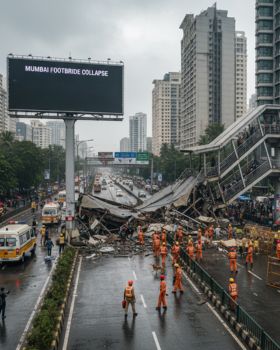
Disclaimer:
This blog post is intended for informational purposes only. The information provided herein is based on publicly available sources and is not intended to assign blame or liability to any individual, organization, or entity. While every effort has been made to ensure accuracy, the content may not reflect the most current findings or expert analyses. Readers are encouraged to consult professional engineers, safety consultants, or legal advisors for specific advice or evaluations related to building safety, structural engineering, or contractor management practices. SHEQ Network does not claim affiliation with or endorsement by any party involved in the Sampoong Department Store incident. Any mention of technology solutions or software platforms is provided as general guidance and not as a guaranteed prevention method for similar incidents.
The Sampoong Department Store collapse in 1995 remains one of the most studied structural failures in recent history. Located in Seoul, South Korea, the event resulted in significant loss of life and brought global attention to building safety, construction practices, and early-warning systems. This blog explores the key facts surrounding the incident—particularly how many floors were in the Sampoong Department Store and what factors contributed to the collapse—offering clear and useful information for professionals, safety managers, and the general public alike.
Overview of the Sampoong Department Store
The Sampoong Department Store was a large commercial complex in the Seocho district of Seoul. It served as a popular shopping destination, housing retail stores, restaurants, and other facilities across multiple levels.
Sampoong Department Store Total Floors Before Collapse
Before the collapse, the Sampoong Department Store had five floors above ground and one basement level. Originally planned as a multi-level structure, the building served thousands of visitors daily and stood as a significant commercial hub in the area.
Key Events Leading Up to the Collapse
The building’s structural performance showed signs of stress in the period leading up to the event. Cracks were reported on some floors, and vibration issues were observed. These signs highlighted the need for monitoring and evaluation.
On June 29, 1995, the building collapsed suddenly, resulting in a large-scale emergency response effort. The incident is often referenced in academic and professional engineering literature for its impact and the learning opportunities it presented.
What Happened During the Collapse?
The South Korea mall collapse occurred over a short span of time. At approximately 5:52 p.m., loud noises were reported by those in the building. Within minutes, large sections of the structure gave way. The center portion of the building collapsed entirely, while some peripheral areas remained partially intact.
Witness reports and official investigations described a sequence of failure starting from the upper floors. The concentrated weight and possible distribution of structural loads may have played a role in how the collapse progressed.
Engineering and Structural Considerations
While the complete set of technical factors is complex, several structural observations were made during the investigation process:
- Load distribution and column alignment were assessed as part of the official review.
- Use of materials and design practices played a role in understanding how the structure handled stress.
- Building layout and mechanical installations, including HVAC systems, were included in the engineering evaluation.
These factors, when analyzed collectively, offered insight into why the structure was not able to withstand the forces it encountered.
How Many Floors Were in the Sampoong Department Store?
To directly answer the question—the Sampoong Department Store had a total of five above-ground floors and a basement. This information is important not only for historical reference but also for professionals reviewing similar multi-story commercial building projects.
This detail is frequently searched and discussed in academic studies and safety management resources to understand how vertical load management affects large structures.
Safety Insights from the Sampoong Mall Disaster
Although this was a rare and specific incident, the Sampoong mall disaster provided numerous insights that are still relevant today:
- Monitoring early signs of structural stress, such as cracks or vibrations, can be helpful in managing building health.
- Regular safety inspections and audits may help identify risks that are not visible to the casual observer.
- Communication among operational, engineering, and safety teams plays a critical role in addressing emerging issues effectively.
While no system can prevent every incident, these approaches can support the safe operation of complex structures.
Learning from the Past: Global Impact
The Sampoong department store collapse influenced construction safety standards, building codes, and compliance policies not just in South Korea, but in many countries worldwide. It became a reference point for new urban safety initiatives and was included in training programs for engineers and architects.
The event also encouraged the development of risk assessment models and highlighted the importance of documentation, data tracking, and proactive maintenance systems.
Could Modern Tools Help in Similar Situations?
Today, technology plays a growing role in enhancing construction safety and operational awareness. While it’s not possible to predict every outcome, modern systems could help teams better manage information and respond to warning signs more efficiently.
For instance, digital tools can assist in:
- Tracking safety checklists and structural audits.
- Managing access permissions and contractor workflows.
- Centralizing documentation for review and approvals.
It’s important to recognize that while these tools support better oversight, outcomes depend on how information is used by decision-makers.
Conclusion: Promoting Safer Projects with Better Oversight
The Sampoong mall disaster emphasizes the importance of learning from real-world events to inform future safety practices. Understanding the Sampoong Department Store total floors before collapse and the structural considerations involved helps guide professionals in making informed choices during project planning and execution.
To support these goals, Contractor Management Software solutions are now available that could help organizations enhance their operational visibility, improve compliance, and organize workflows efficiently:
- Easily store and manage contractor qualifications and documentation.
- Schedule and record safety inspections and training.
- Improve audit readiness and reduce administrative workload.
- Assign digital work permits with built-in safety checklists.
If your organization is looking to strengthen its contractor safety practices, consider exploring our Contractor Management Software platform designed to meet today’s complex compliance and operational needs.
🔗 Learn more at sheqnetwork.com and transform the way you manage contractor safety today.
👉 Ready to see it in action? Book your free demo here!
Ready to transform? Contact us today at info@sheqnetwork.com or call us at +353 21 4536034 for a personalized demo!




3 Comments